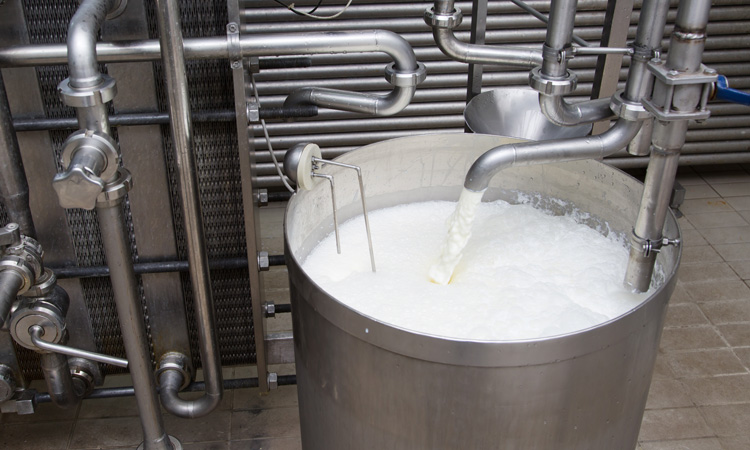Milk pasteurization: could tuberculosis be slipping into our breakfast bowls?
- Like
- Digg
- Del
- Tumblr
- VKontakte
- Buffer
- Love This
- Odnoklassniki
- Meneame
- Blogger
- Amazon
- Yahoo Mail
- Gmail
- AOL
- Newsvine
- HackerNews
- Evernote
- MySpace
- Mail.ru
- Viadeo
- Line
- Comments
- Yummly
- SMS
- Viber
- Telegram
- Subscribe
- Skype
- Facebook Messenger
- Kakao
- LiveJournal
- Yammer
- Edgar
- Fintel
- Mix
- Instapaper
- Copy Link
Posted: 10 December 2019 | Chris Elliott, Javier Lou Franco, Joost Nelis | No comments yet
The pasteurization of milk is said to carry benefits, such as the prevention of pathogens, but some argue that the process destroys key benefits in milk. Here, Chris Elliott, Javier Lou Franco and Joost Nelis from Queen’s University Belfast discuss.


Milk is a rich source of vital nutrients. However, it can also be a source of pathogens if not properly handled. To avoid such risks, milk pasteurization became almost mandatory since its invention in the nineteenth century by Louis Pasteur. The process usually consists in heating milk to 72°C for 15 seconds to eliminate potential pathogens and extend shelf-life. This has kept milk safe from infectious agents ever since, including Mycobacterium bovis, a bacteria that can be present in the milk of infected cows, causing tuberculosis in cattle and humans alike1. The defenders of this heat treatment claim that pasteurization is imperative to ensure safety while it is innocuous enough to preserve the characteristics of the milk2. Detractors, however, claim several key benefits of raw milk are lost through this heating process. Therefore, the controversy continues.
Milk pasteurization became almost mandatory since its invention in the nineteenth century by Louis Pasteur
The claimed benefits of raw milk
Organic Pastures, a major commercial raw milk producer, has claimed a large number of important health benefits of drinking raw milk compared to pasteurized milk, such as:
- Raw milk being a more nutritious food product containing a wide array of minerals, vitamins, antioxidants and fatty acids at higher levels than heat-treated milk
- Raw milk being a rich protein source that contains all nine essential amino acids and that drinking raw milk can reduce age related muscles loss and better physical performance
- Raw milk lowers the risk of obesity.
Several of these arguments are supported by others including the Weston A. Price Foundation, a HuffPost blog and a website listing over 100 raw milk suppliers in the UK. Interestingly, these sources even go a step further and suggest that pasteurized milk may cause allergy, asthma and cancer while raw milk may protect against these conditions. They further claim that pasteurization has become irrelevant due to government hygiene measures put in place during milk production and transportation.
As a result of the claimed benefits (be they true or otherwise), raw milk production and consumption is experiencing a large rise in popularity in Europe and the US. Raw milk vending machines have been installed in many EU countries and the number of registered raw milk producers has kept growing.
Raw milk production and consumption is experiencing a large rise in popularity in Europe and the US
Unfortunately, peer reviewed scientific evidence supporting the claimed benefit is often not given on the sites mentioned. Moreover, where evidence is cited, it is often incorrect or misleading. A good example is the following claim on the website of Organic Pastures: “In fact, several studies have demonstrated that drinking raw milk after a workout can decrease muscle damage, promote muscle repair, increase strength and even decrease muscle soreness”3,4. The statement cites recognised scientific studies. However, these studies did not look at raw milk benefits, but at the effect of fat-free or normal milk intake.
Finding such sources of misinformation can make one wonder how many of the alleged benefits of raw milk are actually supported by robust scientific studies. We decided to look at these systematically to see what is fact and what is fiction.
Raw milk benefits demystified
Raw milk being a more nutritious food product
Studies regarding the effects of pasteurization on fatty acids showed an unaltered profile after pasteurization5,6. Supporting these findings, a systematic review comparing 40 scientific studies as well as a follow up review undertaken in 2013 concluded that vitamin A, whose presence in milk is one of the main sources for humans, did not show decreased levels following pasteurization7,8. Other vitamins such as B12 and E did show qualitative reduced concentrations in pasteurized milk. However, milk is not considered an important source for these two vitamins7. Vitamin B2 (key for catabolism), on the other hand, was seen to have its presence significantly reduced after heat treatment. Finally, no difference was observed whatsoever for minerals and trace elements levels before and after pasteurization8.
Raw milk being a rich source of essential amino acids
This is undoubtedly true, but equally true for pasteurized milk. The three-dimensional structures of proteins may be affected by heat treatment, leading to loss of function of some proteins5, 9. The amino acids themselves however cannot be damaged by mild heat treatments, requiring temperatures above 200 °C to decompose them, well above that used in pasteurization.
Raw milk lowers the risk of obesity
No peer reviewed scientific studies were identified that studied the effects of raw milk on obesity risks. However, consumption of heat treated high fat milk was identified as a factor that lowered the risk of obesity10, 11.
Cancer risks of pasteurised milk
A systematic review pooling all research on prostate cancer risk and total dairy intake until 2018 showed that between 0.2-1.2 percent of the prostate cancer diagnosis may be associated with dairy intake. However, the researchers stressed that the evidence was not very consistent and did not justify a reduction in dairy products consumption. Regarding raw milk consumption specifically, another systematic review of 2011 did not support an association between cancer risk and raw milk consumption, although some inconclusive studies did show a slight reduction in rectal cancer7. However, a similar observation was made in a systematic review from 2018, but this time it was found the reduction was associated with pasteurized milk intake.
Asthma and allergies
A large epidemiological study carried out in more than 7,000 European school-aged children has shown that raw milk consumption is inversely associated to asthma and allergy development (such as hay fever)12. It is believed that higher levels of the whey proteins in raw milk (which are denatured and aggregated by the heating process 9) are behind asthma protection, but this does not explain the reduced allergy outcomes. Despite lacking a good understanding of the mechanisms underlying this protective effect of raw milk, based on the immunomodulatory capacity of many whey proteins in their native state13, further meta-analyses have agreed on the protective association with allergy development7.
Professor Chris Elliott will be speaking at Food Integrity 2020. To find out more about food safety, food fraud and evolving industry concerns, register your interest here!

Has pasteurization become irrelevant?
Before its adoption in the US in 1938, about 25 percent of all foodborne illness outbreaks were associated with milk, whereas this percentage had dropped below 1 percent by 2011 (FDA). However, the number of outbreaks being reduced does not mean that pathogenic bacteria such as Escherichia coli, Listeria monocytogenes, Salmonella or Mycobacterium bovis cannot be present in milk. Instead, this is the consequence of exhaustive tests in the herds and heat treatment of milk to ensure that no pathogenic bacteria remain in the finished dairy products. Very importantly, according to reports produced by the European Food Safety Agency, the regional prevalence of tuberculosis-positive cattle herds can reach 18 percent in some areas of the EU (2015 data).
The number of outbreaks being reduced does not mean that pathogenic bacteria such as Escherichia coli, Listeria monocytogenes, Salmonella or Mycobacterium bovis cannot be present in milk
A case reported in a farm in Ireland rekindled the debate, after M. bovis was detected in milk from infected cows1. Five of six family members were positive on the Mantoux test 14 after consuming raw milk, leading to a four-year-old boy being treated as an active case of tuberculosis and a seven-year-old as a latent case. Different antibiotic cocktails (including ethambutol, pyrazinamide, rifampicin, isoniazid and azithromycin) were used during a 19-month treatment that compromised the health of both children.
The government regulations today
There are valid worries that current EU regulation is not sufficiently robust to protect the public from the dangers of raw milk. Despite the well-established threat that raw milk poses to human health, its production and commercialisation is legal according to EU laws. Two standards must be met for raw milk to be commercialised: less than 20000 cfu/ml (i.e. living microbes per ml) at 30°C and less than 100 cfu/ml for coliforms (such as pathogenic E. coli).
Moreover, annual tuberculin tests for cattle are in place to help avoid milk contamination with tuberculosis reaching the market. Considering that wildlife such as badgers can act as a M. bovis reservoir and infect cattle at any time, the measures in place may be insufficient for safe raw milk consumption. This is especially true since the presence of M. bovis cannot be tested in the finished dairy products with the culturing methods mentioned due to its extremely slow growth characteristics.
Despite all the scientific evidence proving the dangers of consuming raw milk and the minor effects of pasteurization from a nutritional point of view, no consensus has been reached yet in regulatory terms of how best to protect the consumer
Thus, there are well founded fears that drinking raw milk may lead to serious safety issues. This situation equally affects the US, where disparate state regulations apply with some states having laws which resemble EU regulations while others allow farms to sell raw milk in a much less restrictive way, such as Arkansas where the responsibility is delegated to the consumer’s good judgement through a label expressing this:
“This product, sold for personal use and not for resale, is fresh whole milk that has NOT been pasteurized. Neither this farm nor the milk sold by this farm has been inspected by the State of Arkansas. The consumer assumes all liability for health issues that may result from the consumption of this product.”
Regulatory perspectives
Despite all the scientific evidence proving the dangers of consuming raw milk and the minor effects of pasteurization from a nutritional point of view, no consensus has been reached yet in regulatory terms of how best to protect the consumer. This situation puts the consumers in a difficult position in which they are entrusted with the responsibility to balance risks and benefits to make a decision without having the most reliable facts available. Many of the drawbacks of the pasteurization process often cited have been refuted, leaving the real risk of finding tuberculosis in the milk you add to your breakfast bowl and that of your children.
References
- https://www.ncbi.nlm.nih.gov/pmc/articles/PMC3113750/
- https://www.ncbi.nlm.nih.gov/pubmed/9501358
- https://www.ncbi.nlm.nih.gov/pubmed/23075559
- https://www.ncbi.nlm.nih.gov/pubmed/17684208
- https://www.ncbi.nlm.nih.gov/pubmed/9602205
- https://www.ncbi.nlm.nih.gov/pubmed/9602205
- https://www.ncbi.nlm.nih.gov/pubmed/22054181
- https://www.ncbi.nlm.nih.gov/pubmed/22054181
- https://www.ncbi.nlm.nih.gov/pubmed/21155907
- https://www.ncbi.nlm.nih.gov/pmc/articles/PMC5552381/
- https://www.ncbi.nlm.nih.gov/pubmed/26912496
- https://www.ncbi.nlm.nih.gov/pubmed/21875744
- https://www.ncbi.nlm.nih.gov/pubmed/30439365
- https://www.ncbi.nlm.nih.gov/pmc/articles/PMC3481914/
About the authors


Chris Elliott
Chris Elliott is currently Professor of Food Safety and Director of the Institute for Global Food Security at Queen’s University Belfast. He has published around 300 peer review articles, many of them relating to the detection and control of agriculture, food and environmental related contaminants. His main research interests are in the development of innovative techniques to provide early warning of toxin threats across the agri-food chains. Chris led the independent review of Britain’s food system following the 2013 horsemeat scandal and he is a member of the New Food Advisory Board.


Javier Lou Franco
Javier Lou Franco is a Ph.D. student working in the development of nanobioanalytical techniques to detect microbiological contamination in food samples. He carries out his research at the Institute for Global Food Security at Queen’s University Belfast. After obtaining his B.Sc. in Biotechnology and M.Sc. in Nanotechnology at University of Zaragoza (Spain), his formation has focused on the synthesis, characterisation and functionalisation of gold nanoparticles to be used in biosensing devices. He has hands-on experience in immunological assays, isothermal DNA amplification, SPR systems and SERS. Overall, he is interested in the development of novel portable diagnostic tools.


Joost Nelis
Joost Nelis obtained a B.Sc. in general Biology at the University of Antwerp in Belgium and a M.Sc. in Biotechnology specialising in Proteomics and Mass Spectrometry. Here he acquired hands on experience with bio-recognition assays, genetic engineering, high-resolution mass spectrometry, surface plasmon resonance and ambient ionisation mass spectrometry. Currently, Joost is a Ph.D. student at the Queens University in Belfast. His work focuses on the development of smartphone hyphenated colorimetric, plasmonic and electrochemical assays for the detection of major food contaminants.
Related topics
Food Safety, Health & Nutrition, Research & development, The consumer









